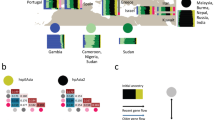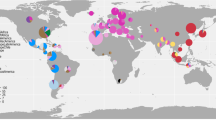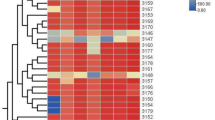Abstract
The human stomach is naturally colonized by Helicobacter pylori, which, when present, dominates the gastric bacterial community. In this study, we aimed to characterize the structure of the bacterial community in the stomach of patients of differing H. pylori status. We used a high-density 16S rRNA gene microarray (PhyloChip, Affymetrix, Inc.) to hybridize 16S rRNA gene amplicons from gastric biopsy DNA of 10 rural Amerindian patients from Amazonas, Venezuela, and of two immigrants to the United States (from South Asia and Africa, respectively). H. pylori status was determined by PCR amplification of H. pylori glmM from gastric biopsy samples. Of the 12 patients, 8 (6 of the 10 Amerindians and the 2 non-Amerindians) were H. pylori glmM positive. Regardless of H. pylori status, the PhyloChip detected Helicobacteriaceae DNA in all patients, although with lower relative abundance in patients who were glmM negative. The G2-chip taxonomy analysis of PhyloChip data indicated the presence of 44 bacterial phyla (of which 16 are unclassified by the Taxonomic Outline of the Bacteria and Archaea taxonomy) in a highly uneven community dominated by only four phyla: Proteobacteria, Firmicutes, Actinobacteria and Bacteroidetes. Positive H. pylori status was associated with increased relative abundance of non-Helicobacter bacteria from the Proteobacteria, Spirochetes and Acidobacteria, and with decreased abundance of Actinobacteria, Bacteroidetes and Firmicutes. The PhyloChip detected richness of low abundance phyla, and showed marked differences in the structure of the gastric bacterial community according to H. pylori status.
Similar content being viewed by others
Log in or create a free account to read this content
Gain free access to this article, as well as selected content from this journal and more on nature.com
or
References
Andersson AF, Lindberg M, Jakobsson H, Backhed F, Nyren P, Engstrand L . (2008). Comparative analysis of human gut microbiota by barcoded pyrosequencing. PLoS ONE 3: e2836.
Atherton JC, Blaser MJ . (2009). Coadaptation of Helicobacter pylori and humans: ancient history, modern implications. J Clin Invest 119: 2475–2487.
Atherton JC, Peek Jr RM, Tham KT, Cover TL, Blaser MJ . (1997). Clinical and pathological importance of heterogeneity in vacA, the vacuolating cytotoxin gene of Helicobacter pylori. Gastroenterology 112: 92–99.
Bik EM, Eckburg PB, Gill SR, Nelson KE, Purdom EA, Francois F et al. (2006). Molecular analysis of the bacterial microbiota in the human stomach. Proc Natl Acad Sci USA 103: 732–737.
Bodger K, Crabtree JE . (1998). Helicobacter pylori and gastric inflammation. Br Med Bull 54: 139–150.
Brodie EL, Desantis TZ, Joyner DC, Baek SM, Larsen JT, Andersen GL et al. (2006). Application of a high-density oligonucleotide microarray approach to study bacterial population dynamics during uranium reduction and reoxidation. Appl Environ Microbiol 72: 6288–6298.
Brodie EL, DeSantis TZ, Parker JP, Zubietta IX, Piceno YM, Andersen GL . (2007). Urban aerosols harbor diverse and dynamic bacterial populations. Proc Natl Acad Sci USA 104: 299–304.
Clarke KR . (1993). Non-parametric multivariate analyses of changes in community structure. Austral Ecology 18: 117–143.
DeSantis TZ, Brodie EL, Moberg JP, Zubieta IX, Piceno YM, Andersen GL . (2007). High-density universal 16S rRNA microarray analysis reveals broader diversity than typical clone library when sampling the environment. Microb Ecol 53: 371–383.
DeSantis TZ, Hugenholtz P, Larsen N, Rojas M, Brodie EL, Keller K et al. (2006a). Greengenes, a chimera-checked 16S rRNA gene database and workbench compatible with ARB. Appl Environ Microbiol 72: 5069–5072.
DeSantis Jr TZ, Hugenholtz P, Keller K, Brodie EL, Larsen N, Piceno YM et al. (2006b). NAST: a multiple sequence alignment server for comparative analysis of 16S rRNA genes. Nucleic Acids Res 34: W394–W399.
Dethlefsen L, Huse S, Sogin ML, Relman DA . (2008). The pervasive effects of an antibiotic on the human gut microbiota, as revealed by deep 16S rRNA sequencing. PLoS Biol 6: e280.
Eckburg PB, Bik EM, Bernstein CN, Purdom E, Dethlefsen L, Sargent M et al. (2005). Diversity of the human intestinal microbial flora. Science 308: 1635–1638.
Faggioni R, Feingold KR, Grunfeld C . (2001). Leptin regulation of the immune response and the immunodeficiency of malnutrition. Faseb J 15: 2565–2571.
Falush D, Wirth T, Linz B, Pritchard JK, Stephens M, Kidd M et al. (2003). Traces of human migrations in Helicobacter pylori populations. Science 299: 1582–1585.
Farrelly V, Rainey FA, Stackebrandt E . (1995). Effect of genome size and rrn gene copy number on PCR amplification of 16S rRNA genes from a mixture of bacterial species. Appl Environ Microbiol 61: 2798–2801.
Freire GN . (2007). Indigenous Shifting Cultivation and the New Amazonia: A Piaroa Example of Economic Articulation. Human Ecology 35: 681–696.
Gill SR, Pop M, Deboy RT, Eckburg PB, Turnbaugh PJ, Samuel BS et al. (2006). Metagenomic analysis of the human distal gut microbiome. Science 312: 1355–1359.
Hugenholtz P . (2002). Exploring prokaryotic diversity in the genomic era. Genome Biol 3: REVIEWS0003.
Jari Oksanen RK, Pierre Legendre, Bob O′Hara, Simpson GL, Peter Solymos, M. Henry, H. Stevens, Helene Wagner . (2008). http://cran.r-project.org/, http://vegan.r-forge.r-project.org/.
Keijser BJ, Zaura E, Huse SM, van der Vossen JM, Schuren FH, Montijn RC et al. (2008). Pyrosequencing analysis of the oral microflora of healthy adults. J Dent Res 87: 1016–1020.
Kunin V, Engelbrektson A, Ochman H, Hugenholtz P . (2009). Wrinkles in the rare biosphere: pyrosequencing errors can lead to artificial inflation of diversity estimates. Environ Microbiol 12: 118–123.
Lane DJ . (1991). 16S/23S rRNA sequencing. Wiley: London, 115–175 pp.
Linz B, Balloux F, Moodley Y, Manica A, Liu H, Roumagnac P et al. (2007). An African origin for the intimate association between humans and Helicobacter pylori. Nature 445: 915–918.
Lu JJ, Perng CL, Shyu RY, Chen CH, Lou Q, Chong SK et al. (1999). Comparison of five PCR methods for detection of Helicobacter pylori DNA in gastric tissues. J Clin Microbiol 37: 772–774.
Masuda N, Church GM . (2002). Escherichia coli gene expression responsive to levels of the response regulator EvgA. J Bacteriol 184: 6225–6234.
Nishi Y, Isomoto H, Uotani S, Wen CY, Shikuwa S, Ohnita K et al. (2005). Enhanced production of leptin in gastric fundic mucosa with Helicobacter pylori infection. World J Gastroenterol 11: 695–699.
Pacifico L, Anania C, Osborn JF, Ferrara E, Schiavo E, Bonamico M et al. (2008). Long-term effects of Helicobacter pylori eradication on circulating ghrelin and leptin concentrations and body composition in prepubertal children. Eur J Endocrinol 158: 323–332.
Perry S, de Jong BC, Solnick JV, Sanchez M, Yang S, Lin PL et al. (2010). Infection with Helicobacter pylori is associated with protection against tuberculosis. PLoS One 5: e8804.
Plebani M, Basso D, Cassaro M, Brigato L, Scrigner M, Toma A et al. (1996). Helicobacter pylori serology in patients with chronic gastritis. Am J Gastroenterol 91: 954–958.
Polz MF, Cavanaugh CM . (1998). Bias in template-to-product ratios in multitemplate PCR. Appl Environ Microbiol 64: 3724–3730.
Rad R, Gerhard M, Lang R, Schoniger M, Rosch T, Schepp W et al. (2002). The Helicobacter pylori blood group antigen-binding adhesin facilitates bacterial colonization and augments a nonspecific immune response. J Immunol 168: 3033–3041.
Rproject. (2008). A language and environment for statistical computing. R. Development Core Team. R Foundation for Statistical Computing, 1090 Vienna, Austria. URL http://www.R-project.org.
Sepp E, Julge K, Vasar M, Naaber P, Bjorksten B, Mikelsaar M . (1997). Intestinal microflora of Estonian and Swedish infants. Acta Paediatr 86: 956–961.
Suzuki MT, Giovannoni SJ . (1996). Bias caused by template annealing in the amplification of mixtures of 16S rRNA genes by PCR. Appl Environ Microbiol 62: 625–630.
Yamaoka Y, Kita M, Kodama T, Sawai N, Kashima K, Imanishi J . (1997). Induction of various cytokines and development of severe mucosal inflammation by cagA gene positive Helicobacter pylori strains. Gut 41: 442–451.
Zhou X, Brown CJ, Abdo Z, Davis CC, Hansmann MA, Joyce P et al. (2007). Differences in the composition of vaginal microbial communities found in healthy Caucasian and black women. ISME J 1: 121–133.
Acknowledgements
This work was supported by UPR grant FIPI 880314. Part of this work was performed at the Lawrence Berkeley National Laboratory under the auspices of the University of California under contract number DOE DE-AC02-05CH11231 and of the Diane Belfer Program in Human Microbial Ecology. We thank Lyd Marie Rodriguez for technical assistance.
Author information
Authors and Affiliations
Corresponding authors
Additional information
Supplementary Information accompanies the paper on The ISME Journal website
Rights and permissions
About this article
Cite this article
Maldonado-Contreras, A., Goldfarb, K., Godoy-Vitorino, F. et al. Structure of the human gastric bacterial community in relation to Helicobacter pylori status. ISME J 5, 574–579 (2011). https://doi.org/10.1038/ismej.2010.149
Received:
Accepted:
Published:
Issue date:
DOI: https://doi.org/10.1038/ismej.2010.149
Keywords
This article is cited by
-
Association of dietary inflammatory index with helicobacter pylori infection and mortality among US population
Journal of Translational Medicine (2023)
-
The Gut Microbiota: a Novel Player in the Pathogenesis of Uterine Fibroids
Reproductive Sciences (2023)
-
Helicobacter pylori and oral–gut microbiome: clinical implications
Infection (2023)
-
Crosstalk between Helicobacter pylori and gastrointestinal microbiota in various gastroduodenal diseases—A systematic review
3 Biotech (2023)
-
Association of Helicobacter pylori infection with survival outcomes in advanced gastric cancer patients treated with immune checkpoint inhibitors
BMC Cancer (2022)



